6 Marketing Attribution Models Your Company Can Leverage
Marketing attribution is a way of assigning revenue credit to different interactions or touchpoints that occur throughout the buyer’s journey. Those touchpoints can occur in a variety of ways across numerous channels as a prospect engages with marketing and sales.
Measuring marketing attribution helps you understand the value you’re receiving from the efforts you’re spending time and resources on. It can help you identify what strategies are effective and reveal opportunities for expanding your tactics.
The amount of credit or the importance you place on each touchpoint depends on what type of marketing attribution model you’re using.
Single-Touch Attribution Models
Single-touch attribution models give all of the credit for a deal to a single touchpoint. Solely using these types of models isn’t effective for understanding the performance of your overall strategy, but they can give you insights into the impact of individual strategies.
First-touch attribution model
A first-touch model gives 100% of the credit to the first interaction in the buying process, regardless of what that touchpoint is. For example, the prospect could still be anonymous when this interaction occurs and not even convert because of it.
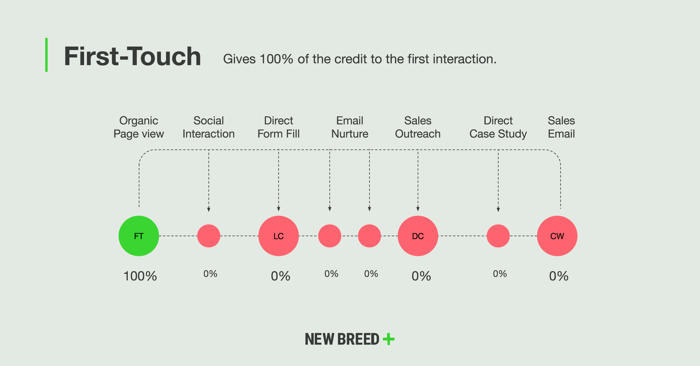
Using a first-touch attribution model will show you where revenue is coming from, which is important to know if you’re focusing on pulling more people into the top of the funnel.
However, this model ignores everything else that happens. Most buying processes are more complex, and often the content interacted with later in the buyer’s journey is more valuable in terms of its purchase decision impact.
Last-touch attribution model
A last-touch model gives 100% of the credit to the last touch that occurred before a deal closed.
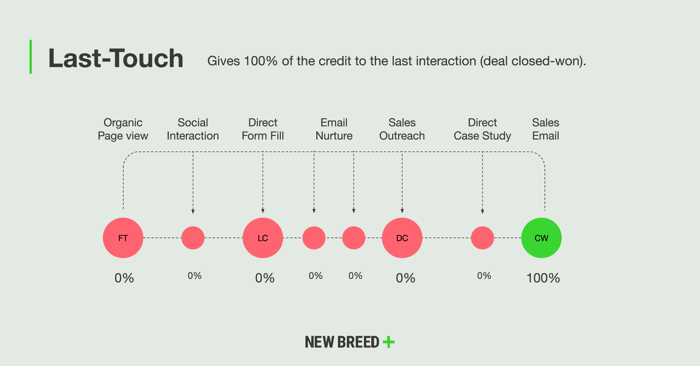
Using it enables you to understand what’s helping you bring deals across the finish line, but ignores where that revenue is initially coming from.
Additionally, if your sales process requires one of your sales reps to be involved in closing a deal, they will always have the last-touch. So unless prospects can sign up for your product or service on their own, this model won’t give you any insights into your marketing efforts.
Multi-Touch Attribution Models
Multi-touch models divide revenue credit for a deal across multiple touchpoints. Each model has a different way of distributing revenue credit across the different touchpoints.
The types of touchpoints that will receive varying percentages of credit include:
- First touch: The first interaction someone has with your company. I.E. a lead comes to your website through search.
- Lead-create touch: The touchpoint that generates a new contact in your database. For this to occur, you acquire identifiable information about a prospect. For example, a person on your website fills out a form to download PCO.
- Deal-create touch: The last touchpoint to occur before a contact becomes an opportunity. For example, a lead requesting a product demo.
- Closed-won touch: The last interaction to occur prior to someone becoming a customer. For example, sales emailing a prospect a proposal.
- Middle touch: Anything that occurs between the touchpoints listed above.
First touch, lead-create touch, deal-create touch and closed-won touch are considered to be points of inflection in the buyer’s journey. Because of that, they’re often viewed as more significant than middle touches.
Linear attribution model
A linear model divides credit equally among every touchpoint that occurs, regardless of what it is. So a middle touch is treated the same as the closed-won touch.
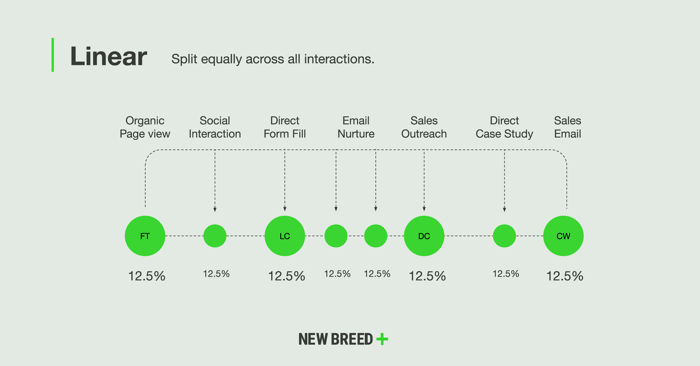
The benefit of this model is that you can see every touchpoint represented, giving you a comprehensive view of which of your efforts impacted a deal.
The downside of using a linear model is that generally some touchpoints are more valuable than others. By weighing everything equally, you won’t necessarily get the insights you need to determine what tactics you should invest more time in.
U-shaped attribution model
The u-shaped model looks at the touchpoints that occur from the first touch to the lead-create touch. The first touch and lead-create touch are both given 40% credit, and the remaining 20% is distributed evenly across the middle touches that happened between them.
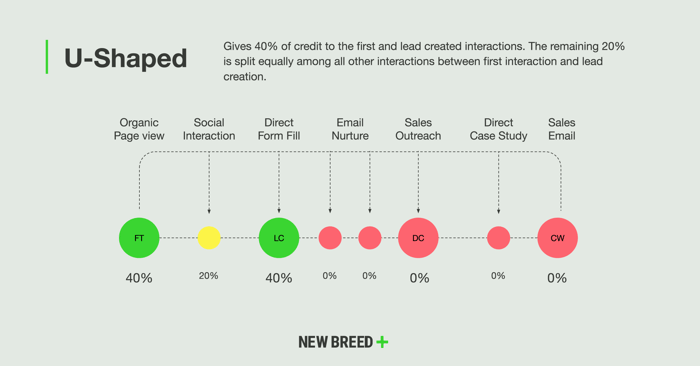
By giving additional weight to some inflection points, the U-shaped model can give you slightly more actionable insights than the linear model. It’s very beneficial to use to improve top-of-funnel strategies.
However, while it can help you figure out to acquire and convert leads initially, it doesn’t show you how to nurture them or close them into customers.
W-shaped attribution model
The w-shaped model looks at the touchpoints that occur from the first touch to the deal-create touch. The first touch, lead-create touch and deal-create touch each receive 30% attribution, and the remaining 10% of the deal is evenly distributed across the middle touches that occur between them.
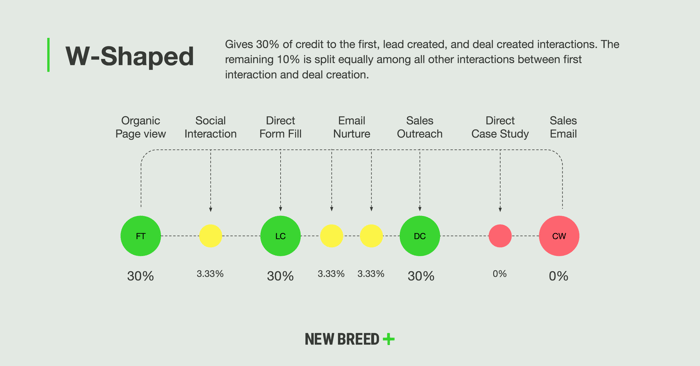
This model gives you more insight into how marketing is impacting the buyer’s journey, and by giving more weight to inflection points you get enough of an understanding of what tactics are working that you can alter your strategy.
However, by not looking past the deal creation, you’ll be missing out on the impact of your efforts that occur after a lead is handed off to sales. If marketing really isn’t involved during the sales process at your company then this isn’t an issue, but if marketing is still communicating with the prospect or creating sales enablement materials for the deal-to-close nurture, then this model won’t provide you with a holistic picture of your work’s impact.
Full path attribution model
A full path model takes into account every single touchpoint that occurs and gives 22.5% credit to the first touch, lead-create touch, deal-create touch and closed-won touch. The remaining 10% is distributed evenly across all middle touchpoints.
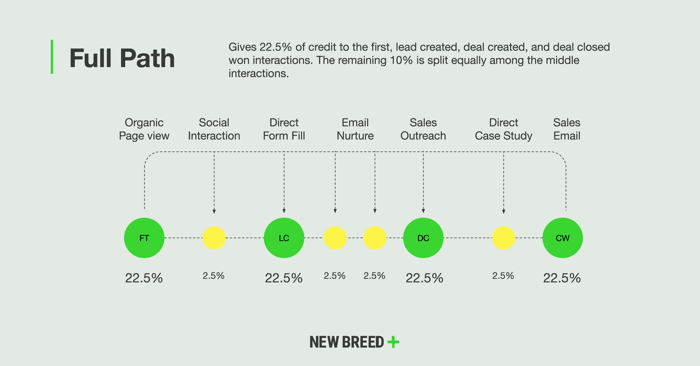
By including all touchpoints and giving credit to major inflection points, this model has all the benefits of the linear and the w-shaped models.
However, if you have a clear distinction between where marketing and sales are responsible for the buyer’s journey, the later touchpoints represented in this model won’t be valuable for you. The same amount of credit will be shared amongst more touchpoints, which can make it less obvious what marketing tactics are having the most impact.
The Takeaway
Marketing attribution can seem daunting because it requires a lot of data and quantifies your success in a different way. By measuring marketing attribution, you’re looking beyond how many leads your closing to how much revenue you’re influencing. Doing so can improve your efforts as a whole and prove the value of your work to the rest of your company.
Tools like HubSpot Enterprise and Bizible make it easy for you to create revenue attribution reports and gain the insights you need to optimize your marketing strategy.
As you start looking at marketing attribution, keep in mind that there is no one-size-fits-all model. You’ll learn the most by looking at multiple models and taking the goal of a strategy into account.
Guido Bartolacci
Guido is Head of Product and Growth Strategy for New Breed. He specializes in running in-depth demand generation programs internally while assisting account managers in running them for our clients.





